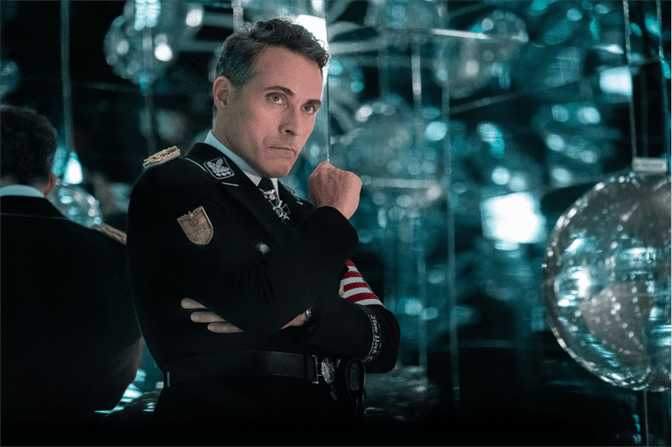Amazon’s controversial series “The Man in the High Castle” has received a great deal of backlash since its debut in 2015. There were advertisements on billboards and even New York City subway cars plastered with offensive images like the Nazi Swastika in order to circulate talk around the show.
The series answers the horrifying question: What if the Axis Powers won World War II?
The show is based on the book of the same name by Phillip K. Dick. Despite the ongoing mixed reactions, Amazon released its fourth and final season on Nov. 15.
With a long list of directors, the storyline of the series takes place in an alternate 1960s, two decades after America’s defeat in World War II.
Instead of the Americans dropping the atomic bomb on Japan, the Nazis dropped it on Washington D.C., leaving the country in ruins. Nazi Germany helped the United States recover and took control of everything east of the Mississippi River, renaming it the Greater Nazi Reich.
Meanwhile, the Japanese Empire partook in an even bigger attack than Pearl Harbor and took over the west coast, now called the Pacific States of America.
Once you've entered our world, you'll never forget it. See why critics are calling The Man in the #HighCastle a "wild and fulfilling" final season. pic.twitter.com/oC25vA0oeT
— The Man in the High Castle (@HighCastleTV) November 26, 2019
The two powers created a neutral zone in between each other along the Rocky Mountains. This is where a majority of the “outcasts” in society relocated, including Jews, African Americans, handicapped and other minority groups deemed unworthy in the eyes of America’s new totalitarian governments.
For viewers to understand the entire story and plot of the series, they must begin at the first season. There are certain events that occur in previous seasons that are crucial to the storyline.
The series revolves around a collection of film reels that Trudy Crain hands over to her sister Juliana, played by Alexa Davalos, after she is shot by Japanese soldiers in the streets of San Francisco.
These film reels were created by the man known as the Man in the High Castle, whose real name is Hawthorne Abendsen and is played by Stephen Root. Abendsen’s reels show the war with an American victory and possession of them is a form of treason in both the Pacific States and the Greater Reich.
These film reels spark resistance in Juliana as she makes her way into the neutral zone. From there, she goes on a wild adventure that takes her into the heart of the Reich, and even different dimensions where the war ended the way it was supposed to. Along this journey, she spreads the visions of democracy pictured in the films.
One word to describe the imagery of the series is horrifying. After watching the entire series and seeing the gruesome Nazi policies in action in the United States, it should make viewers think about current events and hope that America will never get to that point.
The sights of a crippled Washington D.C. and American monuments that represent freedom and democracy such as the Liberty Bell and Statue of Liberty being burned, bombed and replaced by Nazi propaganda can be painful to watch. The special effects are realistic and give iconic locations like Times Square a gruesome, totalitarian makeover.
With all of the horrors this series brings, it also sheds some light on the “monsters” behind imperialism and Nazism.

Rufus Sewell plays John Smith, the ruthless but family oriented leader of the Greater Nazi Reich.
Photo courtesy of Amazon Studios
One of the most notable character developments is the leader of the Greater Nazi Reich John Smith, played by Rufus Sewell.
At first glance, John is a heartless, ruthless dictator just like Nazis who came before him. However, as the series goes on, viewers get to see that he is a family man who will do anything to protect his wife Helen, played by Chelah Horsdal, his two daughters, Amy and Jennifer and his eldest son Thomas.
In the Pacific States, viewers are introduced to Nobusuke Tagomi, played by Cary-Hiroyuki Tagawa, who is the leader of the newly conquered territory, and Takeshi Kido, leader of the Japanese secret police, the Kenpeitai, played by Joel de la Fuente. Both are mostly referred to by their last names throughout the series.
Both men are also very family-oriented. Tagomi lost his wife and son in a previous tragedy before the timeline of the show, but he has visions of them being alive. Kido also shows compassion for his son Elijah, who suffers from post-traumatic stress disorder.
Overall, this series is one that will keep viewers on their toes. It may get confusing when characters begin talking about “different worlds,” but it is worth rewatching to understand the concept, as it plays a major role in the later seasons and eventually the downfall of both powers.
For those who are easily offended by imperial Japanese and Nazi symbols, this is not the best series to explore. But, for all of the venturous science fiction nerds and alternate history geeks in love with Dick’s book and ready to binge-watch this holiday season, Amazon’s “The Man in the High Castle” promises shock, thrills and plenty of goosebumps.


